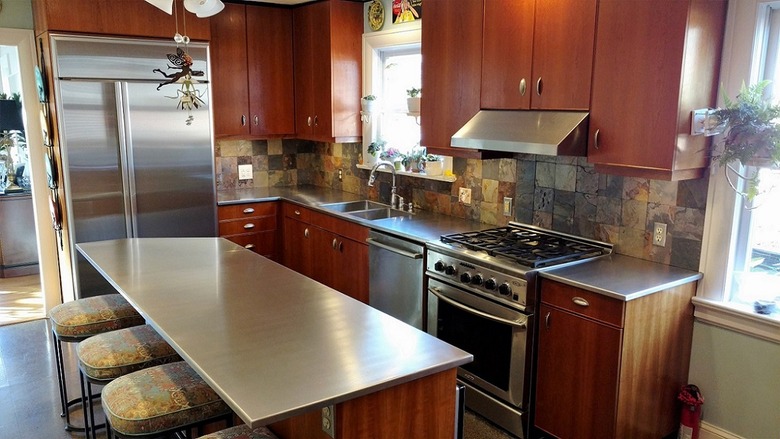How To Remove Bleach Stains From Stainless Steel
We are accustomed to thinking of stainless steel as impervious to stains and corrosion, a metal that is practically indestructible. It has "stainless" right in its name, after all. But stainless steel has its vulnerabilities and ordinary household bleach is one of them.
To understand why stainless and bleach don't get along, it helps to know a little bit about what makes stainless steel stainless—stain resistant, really—in the first place. Stainless steel is a tough low-carbon steel alloyed with nickel or manganese, sometimes with other elements like molybdenum and titanium, plus a minimum of 12 percent chromium. The nickel or manganese gives the alloy a stabile crystalline structure that is non-magnetic. The chromium content is what gives stainless steel its corrosion-resistant, stain-resistant properties.
What Makes It Stainless
What Makes It Stainless
The chromium in stainless steel reacts with oxygen in the air to form a thin, invisible layer of chromium oxide over the surface of the steel. This layer, also called the passive layer, protects the iron content of stainless steel from reacting to the acid or alkaline compounds in common foods or from oxidizing in the presence of moisture and oxygen, as ordinary steel does. If scratched or otherwise damaged the chromium, once again exposed to oxygen, repairs the passive layer. In other words, it "heals" itself.
How Bleach Attacks Stainless Steel
How Bleach Attacks Stainless Steel
Household bleach is a dilute solution of sodium hypochlorite, sometimes with other chemicals in small amounts. In addition to its use in the laundry as a whitener, bleach is widely used as an effective disinfectant. When bleach is used or spilled on stainless steel, however, and allowed to remain there for any length of time, dull gray or brownish "stains" can appear on the stainless surface. These so-called stains are not stains at all but actually corrosion.
The sodium hypochlorite in bleach reacts with carbon dioxide in the air to produce chlorine gas, a powerful oxidizer that will attack most metals, including the chromium oxide layer on the stainless steel. Once it has compromised the passive layer, the chlorine goes on to attack the metal itself. Understanding the stain as corrosion is key to correcting the damage.
To remove the discoloration, you need to scrub away the corrosion. Since stainless steel is not plated but is the same all the way through, once you have removed the corrosion, the chromium oxide layer will re-form and protect the finish. The approach you take in restoring your stainless steel surface to its original shine will depend in part on the extent of the damage.
Removing Minor Rust Stains
Removing Minor Rust Stains
Things Needed
-
Baking soda
-
Water
-
Soft cloth (microfiber is best)
-
Soft-bristle brush
-
Soft sponge
- If the rust stain is small and superficial, make a thin paste from baking soda and water. Baking soda is a very mild abrasive and won't cause further damage to your stainless steel.
- With the soft cloth or brush rub the baking soda paste over the stain, taking care to rub in the direction of the grain in the stainless steel finish. Rub until the stain is gone.
- Rinse the surface with a soft sponge or cloth and water.
Removing More Extensive Rust Stains
Removing More Extensive Rust Stains
Things Needed
-
Baking soda
-
Water
-
Soft-bristle brush
-
Old toothbrush
-
Soft sponge
- Dampen the damaged area of your stainless steel. Sprinkle the damp surface with baking soda in an even layer.
- Allow the baking soda to rest on the affected area for about 1 hour.
- Sprinkle or spray lightly the baking soda with water. Scrub vigorously with the soft brush, once again working with the grain of the finish. An old toothbrush may help with problem spots.
- Rinse and wipe clean with a soft sponge and water.
Another Way to Remove Rust Stains
Another Way to Remove Rust Stains
If the baking soda pastes fail to completely remove the rust stains, your next alternative is to try a cleaning product that uses oxalic acid as its active ingredient. Bar Keeper's Friend Soft Cleanser is a popular choice. Other oxalic acid-based cleaners are available as well. Be sure to choose one that is grit-free.
Things Needed
-
Oxalic acid-based cleaner
-
Soft sponge
-
Rubber gloves
- Following the manufacturer's directions, spread the cleaner across the damaged surface.
- With the soft sponge slightly dampened, rub the cleaner across the stain, moving the sponge in the direction of the grain.
- Rinse the surface clean with water and a soft cloth.
Warning
Bleach is not the only cleaner that can mar stainless steel. Avoid any products that contain chlorine, fluorine or bromine. All are in the chloride family.
Stay away from harsh abrasives when cleaning stainless steel. Steel wool scrubbing pads and steel bristle brushes as well as products containing grit can scratch your stainless steel.
In addition to causing scratches, steel wool can leave behind microscopic particles of steel. Unprotected by the chromium oxide film, these particles can rust and cause new discoloration.
